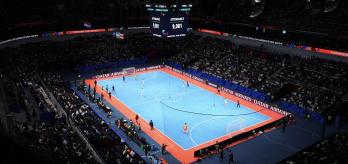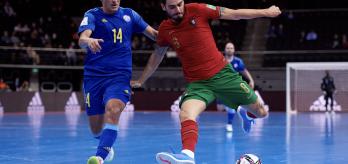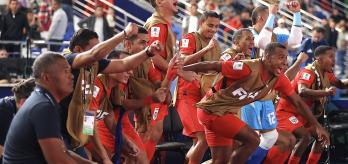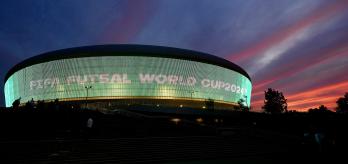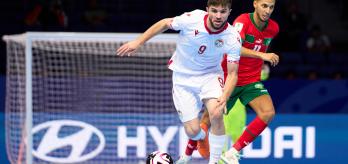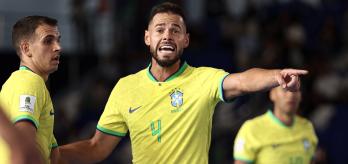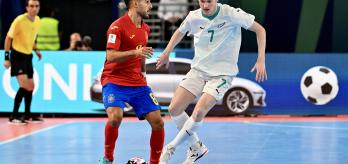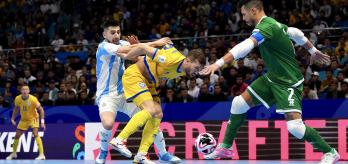The goalkeeper is frequently the last line of defence and often called upon in the most high-pressured of situations. Amongst the most challenging of these situations occurs when defending the space outside the penalty area, progressing into areas of the court without the ability to use their hands, meanwhile leaving the goal unprotected from an error that could prove fatal. At FIFA Futsal World Cup Uzbekistan 2024™, several keepers are showcasing confidence in these situations. Antonio García, a TSG member at the tournament who is also Vietnam’s goalkeeping coach, explains the broader tactical context of defending outside the penalty area, the perceptual and technical understanding goalkeepers demonstrate in these moments and the impact their interventions can have on the following phases of play.
The tactical context
Defensive block
There are several tactical contexts that the goalkeeper must consider before executing a decision. One of the most important of these is the space between themselves and their outfield defensive line. When a team defend in a high block, using man-to-man marking, the space between the goalkeeper and the defensive line will be greater than if the team defend in a low block. In high block scenarios, the goalkeeper must be prepared to defend the space outside the D in advance of the opposition’s attack.
García observed that it is important for the goalkeeper to consider and consolidate all of the available information, including the body language of the opponent who is set to deliver a pass through on goal. He also noted that the goalkeeper must use his intuition and understanding of the game when deciding whether to defend outside of the D or whether to hold ground and face the attacker 1v1 in the penalty area.
“The goalkeeper must act as the last defensive line and dominate the space in front of them. They have to scan and read the body language of the ball carrier. The priority is to get to the ball, using their intuition or stay inside the D and wait for the 1v1.”
Game state
Game state is also an extremely important factor when deciding the actions of a goalkeeper. In Clip 1 below, García used an example from a recent game between Argentina and Afghanistan. He identified that, due to the technical ability of Afghanistan’s players, Argentina decided to primarily defend in a low block. However, in this given situation from the first half, La Albiceleste began pressing in a high block. As such, Argentina’s goalkeeper, Nicolás Sarmiento, was forced to act as the last Defender, since the space between him and his defensive line was now far greater.
García went on to explain that, even though a goalkeeper may not have to come outside of the D as a result of his team’s tactical setup, this may change in certain moments of the match, which will create a need for the goalkeeper to be more perceptive of and responsive to balls being played in behind their defensive line.
“As a coach, you can decide whether your team will defend in a low block, but this is never completely fixed as there may be moments where you can press because of poor control or a backpass, signalling that it is the right time to transfer from a low block to a high block. And then, maybe the opposing team can look for a different solution and play into the space behind the defensive line.”
RELATIONSHIP BETWEEN PERCEPTION AND ACTION
In the previous section, García highlighted the importance of goalkeepers understanding the tactical context of a match when executing certain actions, but he decided to stress the point further by examining the interconnectivity between a goalkeeper’s perception of their surroundings and their eventual technical actions.
Using the visual field
García referenced the value in a goalkeeper using their entire visual field, not only looking at what is happening around the ball but also in other areas where a player could potentially create risk once play further unfolds.
“Each intervention of the goalkeeper is coupled between perception and action. Technical and tactical actions are interconnected and coexist with one another. So, the first thing to do is to scan to get information from the environment. There are no two identical situations in futsal, so you must scan constantly to see what is happening, not only where the ball is, but in other areas of the court. The visual field must be big to try and receive all the information.”
García continued on to make an interesting point regarding the difference between experienced and inexperienced goalkeepers in certain situations while defending the area outside the D. He noted that more experienced goalkeepers have had time to refine their ability to read the game, which can lead to a greater efficiency when defending the space outside their penalty area.
“Many experienced goalkeepers can identify the situation faster and better with more efficiency than young goalkeepers. So, it means that he is reading the game better than an inexperienced goalkeeper.”
Perception leading to action
While using their visual field is a significant skill-set for a goalkeeper to absorb as much information as possible, they must also take into account other relevant factors, for example, the current scoreline, whether or not they are already on a yellow card and the quality of the closest opponent on the ball. “Goalkeepers must make decisions depending on the path of the ball from the opposition, the angle of finishing, possible receptors of the pass, and their position to the closest opponent,” adds García.
Firuz Bekmurodov was a goalkeeper incredibly active in his team’s campaign, attempting 17 defensive actions in Tajikistan’s three games; his total attempts are eight more than the next goalkeeper after 42 game being played. Below, in Clip 2, we see an example of Bekmurodov’s ability to perceive and act in practice.
Furthermore, García noted that there is no such thing as perfect technique and that each intervention from the goalkeeper demands a different response, creating a need for the goalkeeper to be adaptive to the situation. This can mean that the goalkeeper will choose to clear the ball, pass to a team-mate or even shield the ball out of play.
“Can the goalkeeper clear the ball? Can they control the ball and pass to a team-mate to enable play to continue, or can they perceive the flight of the ball and shield it until the ball goes out of play?”
THE PHASE FOLLOWING THE INTERVENTION
Finally, García explored the interconnectivity of the goalkeeper’s actions further by analysing the consequences of each intervention. For instance, a well-executed intervention by a goalkeeper outside the D can lead to a turnover of the ball and an attacking transition.
Vietnam’s goalkeeping coach outlined the four different phases of an intervention and believes that it is important for a goalkeeper to master all four phases to successfully defend the area outside the D. The four phases are:
- Preventive
- Alertness
- Direct intervention
- Consequence
“Usually, coaches focus their sessions only on the ‘direct intervention’ phase, but they forget about ‘alertness’ and ‘consequence’. They also forget that each action has a consequence so it is important to master all four phases,” he explained.
In Clip 3 below, Venezuela goalkeeper Villalobos provides his team defensive balance by occupying a central location of the court while his team-mates are providing width. His intervention provides continuity to Venezuela’s attack, cutting out three Iran players from the game – a clear example of why “consequence” should factor into a goalkeeper’s decision-making.
With Clip 4, García provided an example of a situation where the goalkeeper succeeded in all four phases. Tajikistan goalkeeper, Bekmurodov, defends the space outside the D very well following a Portugal attack. Instead of clearing the ball, shielding it out of play or passing to a team-mate, Bekmurodov knows that there are only a few seconds left on the clock and has an attempt on goal himself, which is a consequence of his well-executed intervention.
KEY INSIGHTS
-
A goalkeeper’s technical execution is intertwined with their tactical understanding of the game. These facets cannot be separated as completing a successful action stems from the goalkeeper’s perception of his surroundings, before concluding on the best way to act.
-
No two defensive situations are the same. Therefore, it can be more effective to perceive “good” technique as something relative to each situation, rather than looking for a blanket application.
-
It is important to coach a goalkeeper to master all four phases of an intervention outside the D: preventive, alertness, direct intervention, and consequence. This will aid the goalkeeper to not just be more perceptive to dangerous situations, but to also be more aware of the consequences of the decisions that they make.






